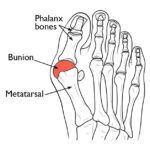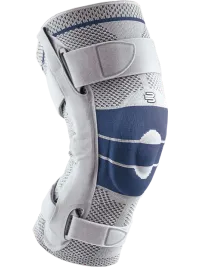What causes bunions?
Many factors are associated with bunions, but there is generally not a single identifiable cause. Family history and poorly fitting shoes are commonly reported. Other causes can include trauma, neuromuscular factors, rheumatoid arthritis, and other inflammatory conditions.
Can bunions be prevented and will my bunion worsen over time?
Bunions may become painful if they are allowed to progress, but not all bunions progress. Many bunion problems can be managed without surgery. In general, bunions that are not painful do not need surgical correction. For this reason, orthopaedic surgeons do not recommend "preventive" surgery for bunions that do not hurt; with proper preventive care, they may never become a problem. A bunion can become more difficult to treat over time, especially if the bunion pushes on the second toe and creates a "hammer toe."
What can be done for bunions?
Early conservative treatment consists of shoe wear modifications that may include going up a size in shoes, switching to a wider toe box shoe, and changing to a shoe with more flexible materials. Other options include icing, oral and topical medications, and activity modification. Bunion spacers and splints may also offer some symptom relief but have not been shown to correct deformities long term.
What if I have tried the conservative measures above?
Most of the time, symptoms can be alleviated using the above methods; however, some patients may require surgical correction of the bunion deformity. While over 100 methods have been described for bunion correction, several current options allow for an expedited recovery over more traditional techniques.
What is recovery time from bunion surgery?
Every recovery is based on patient specific factors such as degree of deformity and if the bunion is associated with joint arthritis or joint instability. Other factors include if associated procedures are performed and surgeon technique. Many current techniques allow for immediate weightbearing in a postoperative shoe without the need for a cast. Bunion surgery is largely done as an outpatient procedure with many patients able to walk the same day. In the 1-2 weeks following surgery, patients are encouraged to elevate and limit excessive walking to allow for pain and swelling to resolve. This can ultimately lead to an earlier transition back to regular shoes, which can be as early as 4-6 weeks postoperatively.
What is minimally invasive bunion surgery?
Minimally invasive surgery (MIS) for bunion correction is a technique using small incisions and percutaneous techniques to achieve correction of a bunion deformity. While it is not the right technique for all, newer literature has shown it can be used for mild, moderate and severe bunions. Some benefits of MIS bunion surgery include smaller incisions, less swelling, quicker return to regular shoes and less stiffness.
https://www.footcaremd.org/conditions-treatments/toes/bunions
https://www.footcaremd.org/conditions-treatments/toes/minimally-invasive-bunion-surgery
This article is provided courtesy of Tyler W. Fraser, MD.


